Lately I've been thinking a lot about dreams in all kinds of
contexts. The most literal one is that I've been reading this book by
Stephen LaBerge about lucid dreaming, a very interesting technique to
explore your consciousness and gain awareness over what happens during
sleep. In less literal contexts, dreaming refers to your aspirations
and goals in your life. In fact I believe that those are the most
important for all of us if we want to go beyond our ordinary,
day-to-day events. It can be extremely helpful to figure out what the
goals of your life are such that you will be able to set priorities,
since we live in such a complex and busy world. In order to figure out
our aspirations, it often helps to dream of how we would want to live
our lives, if everything were possible (this was also suggested in a
recent exercise in Karen
Knowler's eZine ). This allows you to go beyond your limitations
and imagine something bigger. The amazing thing is then then when you
make the aspirations, they will actually often materialize often in
unexpected ways. In a book I read years ago by Marion Bradley ("the
Mists of Avalon"), the magician Merlin said: be careful with what you
wish, because it will be given to you.
And after all, how can you follow a path, when you have no idea what
the path is? I believe that one of the highest priorities in life is
finding what the path is and then following it with every bit of
determination you have.
I am a computational cognitive neuroscientist, who also happens to be a Tibetan Buddhist practitioner and an amateur ballet dancer. In this blog I muse about topics at the intersection of these things. #ballet #neuroscience #mindfulness

Sunday, September 24, 2006
Sunday, August 20, 2006
vancouver and raw food experiments

I recently went to Vancouver for the annual meeting of the Society for Mathematical Psychology. It was quite an adventure: even upon flying in there, we could see the snowy Mount Reinier from the airplane. Then flying in Vancouver Bay is absolutely stunning. Vancouver is a quite dramatic city: beaches, mountains and a big city all in one. It has lots of Japanese immigrants, hence sushi is a very popular food and I ended up eating sushi pretty much every day! The conference itself was also quite wonderful - I enjoy these conferences with relatively few attendees. There were some good talks about mathematical psychology and the brain, including great talks by Greg Ashby and Mike Shadlen who come from two opposite directions: Mike Shadlen starts from single neuron firing in monkeys during a decision making task, Greg Ashby starts from box models of the human brain about categorization and works his way down to the neural level, using fMRI. The brain is just so hard!
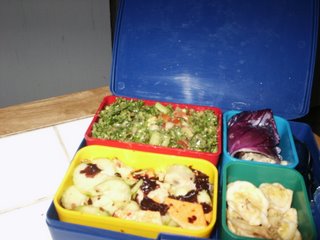
In the recent days I have been experimenting quite a bit with raw food, and one example of those things are some nice raw lunchboxes I created, of which I have pasted a picture here as well. It's quite an adventure. One extremely helpful resource is Karen Knowler's weekly eZine with lots of good articles and tips. What I like about it is that it's a very fast and also quite healthy way of eating, even though I do not think at this point that eating 100 % raw is a great idea. But more raw and unprocessed food is definitely good, and especially because it seems to reduce my cravings for sugar-heavy foods, which is really the main goal.
teachers

"Who is the outer teacher? None other than the embodiment and voice and
representative of our inner teacher. The master whose human shape and
human voice and wisdom we come to love with a love deeper than any
other in our lives is none other than the external manifestation of
the mystery of our own inner truth. What else could explain why we
feel so strongly connected to him or her?"
I decided to write a little about teachers, since teachers of all
kinds play such an important part in my life. I think it is essential
to find good teachers to teach you the art of life. In the beautiful
quote above that comes from Sogyal Rinpoche's book "Glimpse after
Glimpse" (July 27) it is shown how sometimes a teacher we meet can be a
manifestation of what we really need and want to develop. I think good
teachers are very challenging to work with, because they want only the
best you can give them, nothing less. Yet also the interactions with
them are extremely rewarding because not only do they show you the
path, but they are often also great examples. In fact I feel this
applies to not only my spiritual teacher, but also to my ballet
teachers and my thesis advisor, and many of the teachers I have had in
the past. These days, the role of the teacher often gets devaluated
and there is not a lot of respect for them, which greatly diminishes
their ability to actually confer their experience to the
students. This is quite contrary to the way it still works in ballet,
where a teacher is usually not gone against and is curtsied at the end
of every class (to just give some examples). Of course it is also
important to develop critical thinking, and not to take everything the
teacher says at face value, but this can be done after the knowledge
is tested out (this is interestingly enough also what the Buddha seems
to have said to his students: do not believe things I say just because
I say them, test them for yourself). To be pushed by a teacher and to
work very hard can in the end be a joy because it allows you to
transcend your own boundaries. This is why I believe it is so
important to meet good teachers.
Sunday, July 23, 2006
Visit to Berlin


On my summer trip to Europe I not only spent some time visiting
friends and family, and some more time working in Freiburg (Germany),
but I also decided to take the train to Berlin on my way back. Berlin
is quite an impressive city, with a lot of history, albeit somewhat
painful. After arrivinng in the brand new train station Berlin
Hauptbahnhof, I spend the night in a hostel so I could explore the
city the next morning. The first thing to visit was the Pergamom
museum, which hosts a lot of beautiful Roman, Grecian, Babylonian and
Islamic art. It's always a lot of fun to just stand there between the
statues and mosaics and imagine what it would have been like to live
in this time, especially as a woman. An even more interesting thought
experiment is to imagine how it would be to time travel there, knowing
so many more things than they did about the universe and the mind, or
what would they think of a women dancing on the tips of her toes, or
an airplane? You can almost write a novel in your head in this way!
I then went on, passing through Unter den Linden (what a beautiful
street) and the Gendarmen Markt to Checkpoint Charlie, the boundary
between East and West Berlin. Just imagine how many people tried
desparately to escape there, or to reach their friends and family on
the other side of the wall. This is really quite painful. Even more
painful was the headquarters of the Gestapo, close to there. After
walking by the Tempodrome (a very futuristic building which I read
about in the interesting novel Omega Minor by Paul
Verhaeghen) and the Potsdamerplatz, I visited the Holocaust
Monument. The latter was also very painful, with lots of stories of
people who died in this dramatic period of recent European
history. the sadder part however, and the reason why we have to keep
remembering these events is that these things are still happening
these days, think of Rwanda, Tibet and so on... A powerful reminder of
the suffering in the world and for Buddhists maybe also a reminder to
practise tonglen, giving (of happiness) and receiving (of pain and
suffering) or loving kindness and compassion. A more joyful impression
of Jewish life I got in the Jewish museum, which was a quite
interactive display of customs and culture of the Jewish people. One
nice example were the cards in the shape of pomegranates on which
visitors could write their wish. these wishes were then hung in a
tree; pomegranates symbolize something like happiness and hope for the
Jewish people and are often eaten during holidays. In short, Berlin is
quite an eventful city, for which I had way too little time, yet even
short visits are quite good (since I do not very much enjoy being a
tourist, one day was quite good for me!).

Monday, June 19, 2006
mind and life summer research institute

I Just returned from the Mind & Life Summer Research Institute 2006. It was an amazing gathering of Buddhists and scientists and combinations of the two, on the beautiful grounds of the Garrison Institute in Garrison, NY. It is quite unique in that it is a combination of a scientific meeting and a retreat. The retreat began by watching a beautiful documentary about the life of Francisco Varela, who basically started this dialogue between Buddhism and science (the film is called What is Life?). He must have been a very noble being, a rare combination of a brilliant scientist and a beautiful practitioner. At this retreat, we started and ended every day with a solid meditation practice and optional yoga (taught by Jon Kabat-Zinn!). After breakfast we broke the noble silence that was in effect every evening after the meditation practice, and started to discuss theoretical frameworks for the study of contemplative practice, new exciting data, research proposals and difficult issues in this type of research. It was really exciting to be among so many bright and interesting people, and to develop ideas for studies together. at some point I even ended up in a multi-lab lab meeting where we developed a new paradigm that all the labs present were interested in using. A really very friendly and collaborative atmosphere. Yet it was also so incredibly silent - to just simply find the silence within that is always there.

We ended with a complete day of meditation, where we simply looked at our own minds, as if in a laboratory, a laboratory of introspection. This is really what the new discipline of contemplative neuroscience would be like: not only studying meditation or any contemplative practice from the outside, but also very much from the inside, acquiring the experience itself. In here we can very much develop the tools of neurophenomenology, as proposed by Francisco Varela and Evan Thompson. We not only talked about introducing experience or the first person perspective in neuroscience and the study of consciousness, but about lots of other things as well, leading from attention and mind-wandering (discussed by Jonathan Schooler, who developed tools to measure mind-wandering) to emotion regulation and Mindfulness Based Stress Reduction as treatment for diseases like fibromalgyia or depression. Moreover, we even learnt about Christian forms of contemplation: (centering prayer and taxonomies of meditation that are starting to be developed. And finally, this summer institute was an amazing network, or mandala that has been developed of scientists who start collaborations all over - what an amazing coming together of circumstances!
Saturday, June 03, 2006
a taste of mindfulness and compassion
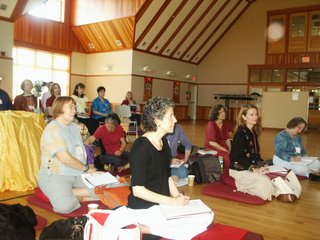
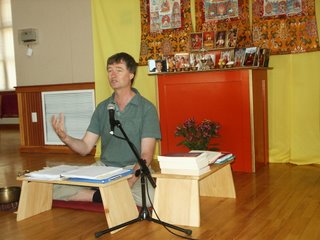
Last week I went to a retreat in Boston (led by one of Sogyal Rinpoche's senior students, Andrew Warr), where we focused on meditation and lojong (mind training in loving kindness and compassion), which was really quite inspiring. It's amazing how being in a quiet environment and listening to the teachings can dramatically bring you back to yourself. It was also very inspiring to see the teachings being presented by someone who clearly had done a lot of practice. In my experience, this gives people often a very profound element of lightness in their being, tranquility and yet very down-to-earth and flexible.
We studied and practiced some of the bodhicitta teachings. I thought one of the most inspiring exercises was a very simple one: putting yourself in the shoes of another person, seeing other people as a another you who also simply want happiness (this was in the context of developing the equanimity aspect of the Four Immeasurables (love, compassion, joy, equanimity)). If we could only practise this in our daily lives, the world would look so much different.
Last week I also saw the movie windhorse, an incredibly inspiring yet very sad movie about the intertwined lives of a nun, an alcoholic and a singer in Tibet (the singer is a Tibetan girl who sings Chinese songs in a discotheque), in occupied Tibet. It's a story about the Tibetan people who want to be free to practise their religion, and the ruthless suppression of that by the Chinese government. I think the most horrible part of such movies is to know that these things are now happening, in Tibet, but also in Iraq, Afghanistan... The windhorse (lungta) is the powerful symbol of being free, when your mind is in harmony with its nature.
Speaking of that, a new, and supposedly quite good, movie has come out, an inconvenient truth, which I hope I will have time to watch in the coming days.
Thursday, May 11, 2006
end of semester reflections
The semester has come to an end - what a transformation of the campus! At the same time, summer is kicking in - we're getting ready for the hot weather. The past weeks had the theme of producing lots of results and giving talks, as well as grading exams and finishing up the class I am the teaching assistant for. It is very interesting to see how people learn at the same time that you are studying human memory (the subject of the course). For your information, spaced repetition is really the best way to learn. Also, really anything you experience changes you, because it changes your episodic memory, which subsequently continues to influence your perception. Interesting how Western science of memory and Buddhism came up with these insights independently!
A recent interest of mine is trying out raw food dishes. I got this amazing cookbook by Jennifer Cornbleet called Raw food made easy, and there is also a very nice website with raw recipes. I think this diet is probably not completely balanced and feasible by itself, but it is definitely good to eat more raw fruits and vegetables, which is also a lot easier as summer comes along.
Another project these weeks has been to work with mindfulness, inspired by the rigpa study pack about meditation. One relatively easy way to develop mindfulness is to tie it for yourself to particular stereotyped actions, such as eating: just remind yourself to think of "mindfulness" as you're eating. This not only transforms your experience of that particular action, but also increases the number of times you remember to remember! The four applications of mindfulness (see "genuine happiness" by Alan Wallace for a good description of those) are also very interesting: I tried to apply the mindfulness of feelings to my hurting toes during pointe class, and it was definitely very helpful. Mindfulness is really an amazing tool!
A recent interest of mine is trying out raw food dishes. I got this amazing cookbook by Jennifer Cornbleet called Raw food made easy, and there is also a very nice website with raw recipes. I think this diet is probably not completely balanced and feasible by itself, but it is definitely good to eat more raw fruits and vegetables, which is also a lot easier as summer comes along.
Another project these weeks has been to work with mindfulness, inspired by the rigpa study pack about meditation. One relatively easy way to develop mindfulness is to tie it for yourself to particular stereotyped actions, such as eating: just remind yourself to think of "mindfulness" as you're eating. This not only transforms your experience of that particular action, but also increases the number of times you remember to remember! The four applications of mindfulness (see "genuine happiness" by Alan Wallace for a good description of those) are also very interesting: I tried to apply the mindfulness of feelings to my hurting toes during pointe class, and it was definitely very helpful. Mindfulness is really an amazing tool!
Saturday, March 18, 2006
antigone: a story of courage and morality

Yesterday I saw a beautiful new ballet by the Rebecca Davis Dance Company. The performance was named Antigone, after the drama by Sophocles. Very interesting was the use of dialogues from the play while the dancers were dancing, which made the dancing very moving, because the story was very clear so the dancing could focus on the feeling. It was amazing to see how modern dance and pointe were combined, in a very high level performance. Also, the story of this courageous woman who decides to thwart a sure death by her father's hand for the sake of upholding her duties as a human being. She faces the lust for power of her father Creon as she goes her own way to bury her brother, and pays for it with her own death. The chase for Antigone after she commits the act of burying her brother was beautifully staged, where the first white-clad people in the court now became all dressed up in leather and their dancing was very square and aggressive. For me it was also the story of staying human, upholding your own morality in a world that sometimes seems to revolve around power, money and recognition, a world that is full of speed and agression. The innocence combined with determination that overcomes that was beautifully portrayed. The picture that goes with this post is from the ballet.
Saturday, March 11, 2006
ballet news and simple living
For ballet there were quite a few interesting challenges in the past classes: at the barre, doing a full turn, ending in the extended leg position at 90 degrees on pointe, repeating this whole exercise in all directions (i.e., en croix). It is definitely not too easy! And then today we ended class not with fouettes but with a series of consecutive turns from 5th position, 16 of them. Being a bad spotter, this was a sure recipe for diziness, so I was amazed I almost made it through 16 of these turns on pointe. But again it was a fun challenge!
During the past week, the campus was almost abandoned since it was spring break. What a transformation! But now campus is in full swing again and I am grading the second exam, woohoo!
Anyhow, i have been thinking a lot lately about leading a simple life. Especially in the US, we tend to waste so much money and stuff, believing that we get happy by buying as much as we can, and doing everything fast and easy, which creates a lot of waste. Luckily, there are some people who do not agree with that. I found this cool site vegan lunchbox, which shows how you can be very creative with lunches that you bring from home, and save a lot of money and waste to boot. Of course preparing such lunches would cost a lot of time but with creativity you can also create nice things with less time. And there are lots of other things that one can reuse, such as bringing your own cup or thermos to talks where they serve tea, or even using cotton menstrual pads of reusable tampons when you're a woman (see glad rags for this creative initiative. I wish more people here would care about the environment, using their bikes instead of cars (although it's not bad in Philadelphia I must say), doing recycling and these kinds of simple things. Especially because judging from the weather here (first 80 degrees and then within 2 days a drop to snow!) we seem to be screwing up the environment quite a bit...
During the past week, the campus was almost abandoned since it was spring break. What a transformation! But now campus is in full swing again and I am grading the second exam, woohoo!
Anyhow, i have been thinking a lot lately about leading a simple life. Especially in the US, we tend to waste so much money and stuff, believing that we get happy by buying as much as we can, and doing everything fast and easy, which creates a lot of waste. Luckily, there are some people who do not agree with that. I found this cool site vegan lunchbox, which shows how you can be very creative with lunches that you bring from home, and save a lot of money and waste to boot. Of course preparing such lunches would cost a lot of time but with creativity you can also create nice things with less time. And there are lots of other things that one can reuse, such as bringing your own cup or thermos to talks where they serve tea, or even using cotton menstrual pads of reusable tampons when you're a woman (see glad rags for this creative initiative. I wish more people here would care about the environment, using their bikes instead of cars (although it's not bad in Philadelphia I must say), doing recycling and these kinds of simple things. Especially because judging from the weather here (first 80 degrees and then within 2 days a drop to snow!) we seem to be screwing up the environment quite a bit...
Monday, February 27, 2006
mind and reality
I spent the weekend in New York City, attending the mind and reality conference. It was really interesting, in many aspects. Not only was the level of discussion about the nature of consciousness (mainly) really high, but also was it interesting to observe the sociology of knowledge. I was surprised at what a language gap there seemed to be between the (neuro)scientists, who tend to speak the language of data, the philosophers, who communicate through mention of different theories and previous philosophers, and Buddhist scholars, who pepper their conversations with lots of Sanskrit/Pali/Tibetan terms. It was quite obvious that we are in dire need for translators, even though some of the speakers did quite a good job at trying to make some steps in translating themselves, which was one of the more interesting things at the conference. Probably a more focused conference, restricting itself for example to the nature of consciousness and trying to discuss the differences and similarities from neurobiological, philosophical and Buddhist perspectives would be more productive. Nevertheless, it was impressive to have so many great minds together. I especially enjoyed the talks about phenomenology by for example Evan Thompson, trying to link a complex systems approach to neuroscience in order to suggest that there is not a separate mind and body, but rather they are co-emergent. A similar point was made in a very interesting essay by William Waldron. I think this is a very fruitful approach, though hard to turn into science. How can we come up with models that are so complex that they represent this co-emergence phenomenon, the necessary nonlinearity of the system?
The next day of that weekend was quite a turn when I attended a rigpa sangha gathering, which operated from quite a different perspective. Sogyal Rinpoche tends to bring the teachings from the direct experience, or from the heart of things, and only then the intellect comes in, whereas at the mind and reality conference most was done from the approach of the intellect, except for a little bit during the presentation of Piet Hut, who encouraged the listeners to experience the world in different ways, demonstrating the phenomenological approach quite beautifully. Anyway, I think it is fruitful to have both, and I wish that personal experience were used more by neuroscientists. who are after all trying to understand how the brain produces cognition.
The next day of that weekend was quite a turn when I attended a rigpa sangha gathering, which operated from quite a different perspective. Sogyal Rinpoche tends to bring the teachings from the direct experience, or from the heart of things, and only then the intellect comes in, whereas at the mind and reality conference most was done from the approach of the intellect, except for a little bit during the presentation of Piet Hut, who encouraged the listeners to experience the world in different ways, demonstrating the phenomenological approach quite beautifully. Anyway, I think it is fruitful to have both, and I wish that personal experience were used more by neuroscientists. who are after all trying to understand how the brain produces cognition.
Thursday, February 23, 2006
faces!

These days I have been working mainly on studies of face spaces, face association and face recognition. In the picture above you can see some sample of my faces. They are hard to recognize, aren't they! I think what is really cool is that we can figure out how the face space of people is represented in their heads, using what is called 'multidimensional scaling'. Trying out different algorithms is one of the things I have been doing lately.
The new year in the Tibetan calendar will start next Tuesday, the 28th. A good time to make some new resolutions about practice, and integrating practice in daily life. Isn't it amazing how often we simply get lost in our thoughts and emotions, and think that is really us? We take our thoughts so seriously, whereas if we simply see we get irritated because we feel somebody is impeding us, the irritation just subsides (at least in my experience). I am hoping that in the new year I will be able to remind myself a little bit more often of these simple facts about my mind, making me hopefully a little happier and less stressed ;-)
Saturday, February 11, 2006
craziness
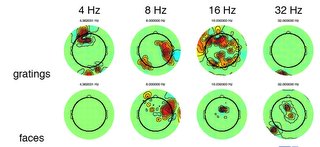
scienceThis week was the first exam for the class I am TAing and it was quite intense: grading 90 exams with 6 essay questions each... And then managing to give a talk too! The picture below is actually one from the talk I gave, showing correlations between summed similarity and activity in different oscillatory bands. The summed similarity is the quantity we believe people compute during a task in which they are asked to say whether they have seen the image in the list of images that was shown a few seconds before. The task is quite hard but my subjects can do it, and their brain activity shows interesting oscillatory patterns during that period. The graph on the left shows for every set of my stimuli the probability that subjects will say "yes", it was in the list as a function of this summed similarity they are computing, and on the brain plots on the right you see the correlation of this summed similarity with the oscillatory power at different frequencies, some time after the probe item was shown. Isn't that cool?

ballet Today I went to ballet class which was again a lot of fun because we actually danced some variations. I was also asked to perform in next year's Nutcracker so I hope I'll be able to actually do that and find time to rehearse. Life is so exciting!
dharma
Next week there will be a very interesting conference at Columbia University in New York, where scientists and philosophers will talk about the nature of consciousness, and its studies using neuroscience and Buddhist contemplation. Check out their blog
Saturday, February 04, 2006
ballet excitement!
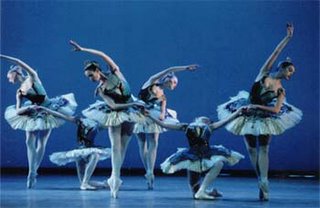
A lot of ballet excitement has been going on: last week was the Prix de Lausanne, one of the most prestigious ballet competitions. They always put the videos of the finals online, which is a great joy to watch. Check out www.prixdelausanne.org.
Last week in class I was for the first time ever able to do 4 fouettes on pointe - woohoo! Ballet is always a challenge, which makes it so exciting!
I also went to see the Pennsylvania Ballet in a set of three Balanchine ballets: Theme and Variations, a very nice technical piece, during which the dancers simply become the music (the picture shows the Mariinsky Ballet in this piece); The Prodigal Son, a story ballet that lacked some depth in my opinion but the depiction of the protagonist was beautiful: from a party animal he turned into a broken man. Also the partnering in this ballet was quite challenging. The third ballet was Western Symphony, which I think must be a joy for the dancers to dance: finally some swinging, yet combined with some challenging leaps and turns. Balanchine really WAS a genious, being able to produce such dramatically different ballets, yet all very good.
Monday, January 23, 2006
self-confidence and education
This week we'll have the first neuroscience recruits come visit Penn again. I like the US system a lot where the university actually invites prospective grad students to visit, and interviews with them. This is not only for the university as a means for selection but also to try to lure the student into studying at the university. Letting the student know in this way that she/he is valued creates a lot of confidence in them; it makes them feel more valued and accepted. This is very important in a time where students are so focused on performance and academic results that they often feel very insecure.
Sogyal Rinpoche teaches that often we are so insecure because we feel that the love we received as a child was always conditional, conditional upon being "good", having good results in school, in sports, in whatever we did. If we could only just remember that no matter what, we can always connect with the gigantic store of love that is somewhere within all of us, that Buddhists call the buddha nature, then we can become so much more confident!
So, both encouraging not to rely too much on achievement for self-confidence, as well as a supportive environment in which the person feels respected are important principles in education.
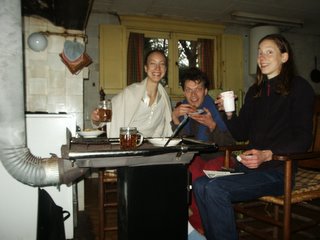
Sogyal Rinpoche teaches that often we are so insecure because we feel that the love we received as a child was always conditional, conditional upon being "good", having good results in school, in sports, in whatever we did. If we could only just remember that no matter what, we can always connect with the gigantic store of love that is somewhere within all of us, that Buddhists call the buddha nature, then we can become so much more confident!
So, both encouraging not to rely too much on achievement for self-confidence, as well as a supportive environment in which the person feels respected are important principles in education.

Tuesday, January 10, 2006
the beauty of dedication
As the new year starts, I always feel it's a time for reflection, and for reshuffling priorities. I think that one of the sicknesses of our current society is an overdose of choices. There is no time to think, yet we constantly have to do different things in order to stay interested and maybe even, to stay interesting for other people. One beautiful movement (I think) is that of the Simple Living Network (www.simpleliving.net). I think that people would probably be a lot happier if they would simply be dedicated to one cause. There is something incredibly beautiful about people who have a lot of dedication to whatever they are doing, such as those people who traverse thousands of kilometers from remote regions in Tibet to the capital Lhasa, all the way prostrating. Isn't that amazing?
Subscribe to:
Comments (Atom)